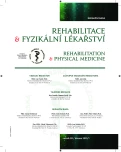-
Medical journals
- Career
Swallowing Disorders In Children - Interdisciplinary Cooperation Physiotherapists with Clinical Speech Pathologist
(Part 1 - Diagnostics)
Authors: T. Nováková 1; B. Bunová 2
Authors‘ workplace: Katedra fyzioterapie, Fakulta tělesné výchovy a sportu UK, Praha vedoucí katedry doc. PaedDr. D. Pavlů, CSc. 1; Neštátna ambulancia klinickej logopédie, Skalica, Slovenská republika 2
Published in: Rehabil. fyz. Lék., 20, 2013, No. 1, pp. 11-16.
Category: Original Papers
Overview
Swallowing disorder in childhood is a major risk factor that endangers the health and even the life of a child. In the text we present a list of risk factors and possible symptoms of dysphagia in children. These signs require the assessment of their severity and follow-up complex examination. One of the diagnostic methods allowing evaluation mechanism of swallowing disorders is videofluoroscopy, which makes possible to distinguish the phase in which the primary fault occurs, its dependence on the consistency of the food or the position of the head to the trunk. This diagnostic together with the results of kinesiological testing can be basis for targeted therapy built on collaboration of clinical speech therapist and physiotherapist within a complex interdisciplinary child care.
Keywords:
dysphagia, feeding, postural child development, videofluoroscopy
Sources
1. ARVEDSON, J. C., BRODSKY, L.: Pediatric swallowing and feeding: assessment and management. Albany, N. Y.: Singular/Thomson Learning, (2nd edition), 2002, ISBN 0-7693-0076-6.
2. BARTOLOME, G., SCHROETER-MORASCH, H.: Schluckstoerungen. Diagnostik und Rehabilitation. Munchen-Jena: Urban & Fischer, 2006, s. 245-370, ISBN -10 : 3-437-47160-0.
3. BUNOVÁ, B.: Skvalitnenie života pacientov s dysfágiou. Trnava, 2010. Dizertační práce na Trnavské univerzitě. Vedoucí práce prof. MUDr. Daniel Bartko, DrSc., obhájena 20. 8. 2010.
4. DANIELS, S. K.: Neurological principles of normal and disordered swallowing. Kurz 6.–7. 11. 2011, Idstein.
5. FREY, S. et al.: Pädiatrisches dysphagie - management.Urban-Fischer, 2011, ISBN 978-3-437-48750-7.
6. HERBST, W.: Neurogene Dysphagien und ihre Therapie bei Patienten mit Trachealkanuele. Schulz-Kirchner Verlag , Idstein, 2004, ISBN 3-8248-0394-1.
7. KIM, Y., McCULLOUGH, G. H.: Maximal hyoid excursion in postroke patients. Dysphagia, 25, 2010, s. 20–25, DOI 10.1007/s00455-009-9224-1.
8. LOGEMANN, J. A.: Evaluation and treatment of swallowing disorders. Austin, Texas, PRO-ED (2nd edition), 1998, ISBN 0-89079-728-5.
9. PIAZZA, C. C., CAROLL – HERNANDEZ, T. A.: Assessment and treatment of pediatric feeding disorders. In: Tremblay, R. E., Barr, R. G., Peters, R. D V. eds. Encyclopedia on Early Childhood Development [online]. Montreal, Quebec, Centre of Excellence for Early Childhood Development; 2004, s. 1–7, dostupné: http://www.child-encyclopedia.com/documents/Piazza-Carroll-HernandezANGxp.pdf [citováno listopad 2012].
10. TEDLA, M. a kol.: Poruchy polykání. Tobiaš, 2009, ISBN-13 : 978-80-7311-105-2.
Labels
Physiotherapist, university degree Rehabilitation Sports medicine
Article was published inRehabilitation & Physical Medicine

2013 Issue 1-
All articles in this issue
- Argumentation for Application of Intentionally Oriented Movements in Physiotherapy
-
Swallowing Disorders In Children - Interdisciplinary Cooperation Physiotherapists with Clinical Speech Pathologist
(Part 1 - Diagnostics) - Facilitated Expectoration by Airway Clearance Techniques in Patients with Significantly Weakened Respiratory Muscles
- Issues of the Locomotor System Injuries Among Golf Players
- Using Dance in Parkinson's Patients Treatment
- Alternative Treatments for Parkinson's Patiens
- Remote Postural Effects Influencing M. Biceps Brachii
- Rehabilitation & Physical Medicine
- Journal archive
- Current issue
- Online only
- About the journal
Most read in this issue- Remote Postural Effects Influencing M. Biceps Brachii
-
Swallowing Disorders In Children - Interdisciplinary Cooperation Physiotherapists with Clinical Speech Pathologist
(Part 1 - Diagnostics) - Facilitated Expectoration by Airway Clearance Techniques in Patients with Significantly Weakened Respiratory Muscles
- Issues of the Locomotor System Injuries Among Golf Players
Login#ADS_BOTTOM_SCRIPTS#Forgotten passwordEnter the email address that you registered with. We will send you instructions on how to set a new password.
- Career

